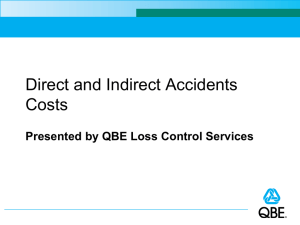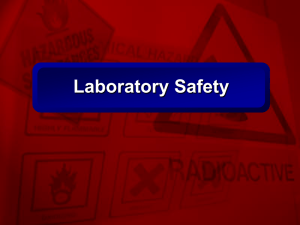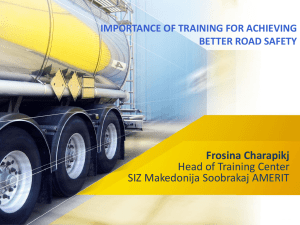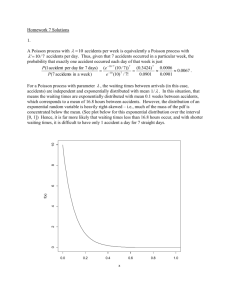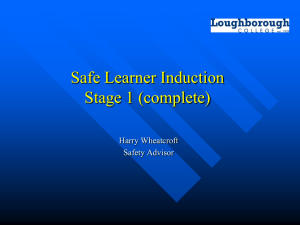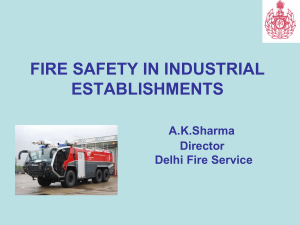A Study of Construction Site Accidents Statistics
advertisement
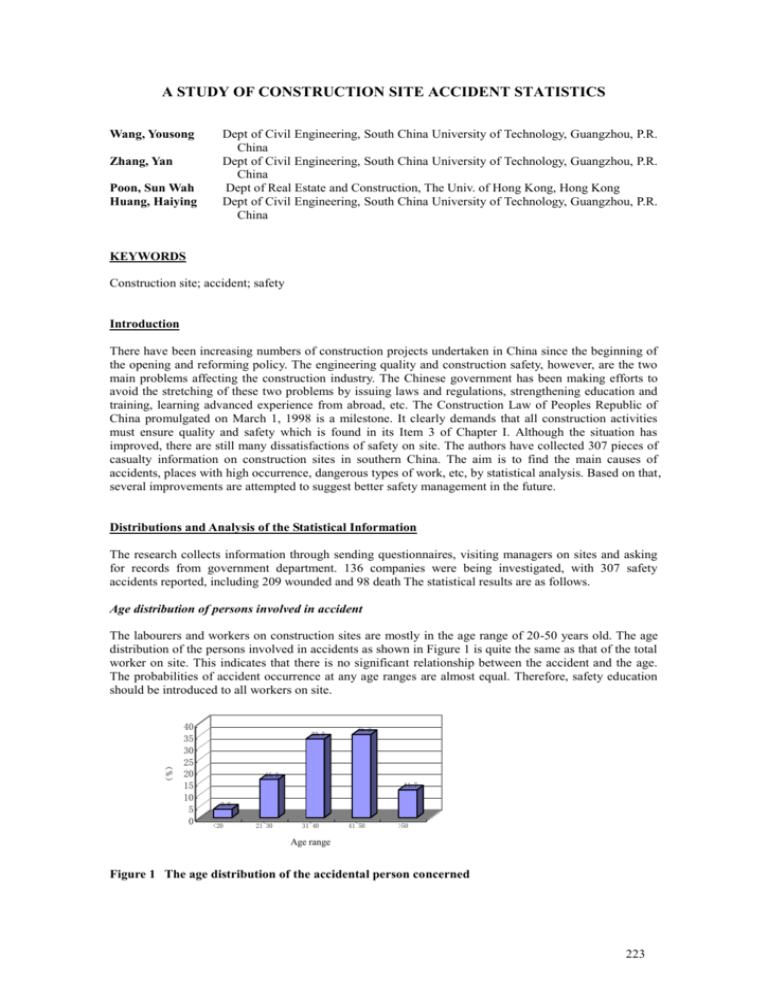
A STUDY OF CONSTRUCTION SITE ACCIDENT STATISTICS Wang, Yousong Zhang, Yan Poon, Sun Wah Huang, Haiying Dept of Civil Engineering, South China University of Technology, Guangzhou, P.R. China Dept of Civil Engineering, South China University of Technology, Guangzhou, P.R. China Dept of Real Estate and Construction, The Univ. of Hong Kong, Hong Kong Dept of Civil Engineering, South China University of Technology, Guangzhou, P.R. China KEYWORDS Construction site; accident; safety Introduction There have been increasing numbers of construction projects undertaken in China since the beginning of the opening and reforming policy. The engineering quality and construction safety, however, are the two main problems affecting the construction industry. The Chinese government has been making efforts to avoid the stretching of these two problems by issuing laws and regulations, strengthening education and training, learning advanced experience from abroad, etc. The Construction Law of Peoples Republic of China promulgated on March 1, 1998 is a milestone. It clearly demands that all construction activities must ensure quality and safety which is found in its Item 3 of Chapter I. Although the situation has improved, there are still many dissatisfactions of safety on site. The authors have collected 307 pieces of casualty information on construction sites in southern China. The aim is to find the main causes of accidents, places with high occurrence, dangerous types of work, etc, by statistical analysis. Based on that, several improvements are attempted to suggest better safety management in the future. Distributions and Analysis of the Statistical Information The research collects information through sending questionnaires, visiting managers on sites and asking for records from government department. 136 companies were being investigated, with 307 safety accidents reported, including 209 wounded and 98 death The statistical results are as follows. Age distribution of persons involved in accident (%) The labourers and workers on construction sites are mostly in the age range of 20-50 years old. The age distribution of the persons involved in accidents as shown in Figure 1 is quite the same as that of the total worker on site. This indicates that there is no significant relationship between the accident and the age. The probabilities of accident occurrence at any age ranges are almost equal. Therefore, safety education should be introduced to all workers on site. 40 35 30 25 20 15 10 5 0 33.3 35.2 16.2 11.7 3.6 <20 21~30 31~40 41~50 >50 Age range Figure 1 The age distribution of the accidental person concerned 223 Work experience of persons involved in accidents Theoretically, the longer of work time and experience on construction sites, the lower rate of accident probability. However, the statistical diagram shown in Figure 2 shows that most accidents involved persons with 1 to 10 years of work experience. The accidents happened at a lower rate for workers with shorter than 1 year and longer than 11 of experience. The reasons are likely to be self-assured capability, paying no attention to safety regulations and carelessness, etc. 50 41.7 40 % 34.8 30 20 10 0 8.3 7.4 4.9 2.9 <1 1~5 6~10 11~15 16~20 >20 Work experience(year) Figure 2 The work experience distribution of the accidental person concerned Weeks on site before accidents occurrence It needs a period of time to suit the situation in a certain site even if the worker is experienced. So, there would be connections between the entering time on the site and the accident occurrence. Figure 3 shows the statistical relation. Most accidents occurred between 1-30 weeks of entering site. Nearly half of the total ranges between 1~10 weeks. In contrast, the accident occurrence rates are relatively low within shorter than one week and longer than half a year. This gives a phenomenon that new comers on sites are usually very careful to suit the circumstance and old workers are familiar to the sites. Both types of workers are unlikely to be involved in accidents. The safety managers should pay much attention to workers having served for one to two months on the site. Their accidental probability is relatively high. 50 47.5 40 % 30 20 17.2 8.3 10 0 16.2 <1 7.4 2.5 0.9 1~10 11~20 21~30 31~40 41~50 >50 Work time on the site(week) Figure 3 The distribution of work time on the site of the person concerned 224 Types of accidents 28.2 21.7 16.6 14.7 7.6 7.6 Others Electrocution Straining Cutting Tumbling Falling 3.6 Struck 30 25 20 % 15 10 5 0 Accident kinds Figure 4 The distribution of accident kinds Types of accident is one of the analyses because it reveals the causes of accident to some extent. From Figure 4, it is known that half of the accidents involved being struck by objects and falling from height. The other types of accidents are tumbling, cutting, straining and electrocuting in frequent orders. These causes are the main threats to workers’ lives on construction sites. The precautions and education are necessary to be taken by workers. Location of accident 25 21.2 20 % 19.7 17.9 15.8 15 15.5 9.9 10 Others Ladder Crane Scaffolding Hoist 0 Hole 5 Accident places Figure 5 The distribution of accident places Analysis of accident locations is also important. It is shown in Figure 5 that most of the accidents occurred at hoists, holes and wells, scaffoldings, cranes and ladders. So warning boards should be erected at these places to call attention to workers of possible dangers. Besides, detailed instructions of works relating to these areas are suggested for regular management to lower accidental possibility. Kinds of Work 25 22.4 20.6 20 15 14.1 12.3 % 3.7 4.6 Others 4.5 Steel-barring 5.1 Concreting Piling Soiling Cutting Moving Scaffolding 0 5.8 Formwork 6.9 5 Maintenance 10 Work kinds Figure 6 The distribution of work kinds relating to accidents 225 Lastly, it is worthy to analyse the kinds of work relating to accidents. The statistics shown in Figure 6 suggest that the vulnerable work kinds are scaffolding work, earth work, piling work, framework, concreting work and mechanical maintenance. Special technical training to the workers involving in those works is recommended to ensure that all workers are qualified. Suggestions Based on the statistics and analysis above, several advices are suggested for improving the safety on construction sites. First of all, the governmental department should pay much attention on the safety on construction sites as roles of guide, educator and inspector. It is necessary to organize activities such as technical training, discussion and seminar on safety, exhibition and public education, experience exchange, workshop, etc. Second, management of the industry needs to be strengthened. The legal regulations should be perfected step by step. An atmosphere concerning safety problem should be built in the society of construction industry. The rewards and punishment of companies should link with their safety records. Emphasis of precautionary idea on safety. Contractors should understand that safety is an important prerequisite to pursue profit. Spread knowledge of advanced experience and technology on safety. Provide protective utilities such as safety net, helmets, boots, gloves, goggles, ear-stoppers. This encourages the creation and innovation of new techniques on construction safety. Bring in life insurance mechanism for workers on sites. Education and protection are one part of the safety issue. On the other hand, accidents are inevitable. So the preparation of handling accidents is necessary. This is an important approach to minimize the economic risk of construction. Concluding Remarks The results of this paper give an understanding of safety issue on construction sites in southern China. The ages of casualties have insignificant relation to the accidents. The most dangerous period is likely to involve workers with about 5-year work experience and 1-30 weeks on certain sites. The kinds of accident are struck by objects, falling from height, tumbling, cutting, straining and electrocuting in frequent orders. The occurrence points are at hoists, holes and wells, scaffoldings, cranes and ladders, etc. The works involved in accidents are usually scaffolding work, earth work, piling work, framework, concreting work and mechanical maintenance. Therefore, the authors suggest strengthening the supervision role of government, to execute self-discipline in the industry, to educate the workers with awareness of safety, to change contractors’ idea, to spread safety protective measurements, and to bring in life insurance mechanism for better handling of accidents. Acknowledgements The Authors are grateful to all persons visited in this research. Anonymous staffs in department of construction management offered generously valuable basic data. Without their help, this paper will be impossible. Reference Safety Management in the Construction Industry – Asia Experience, Safety Specialist Group, Hong Kong Institute of Engineers, 2000. Green Cross, Occupational safety and health council of Hong Kong, Vol 11, 2000. 226 The Guidelines on Occupational Health and Safety Management Systems for the Construction Industry of Japan, Japan Construction Safety and Health Association. http://www.kensaibou.or.jp Construction Site Safety, A guide for managing contractors, R. Hislop, Lewis Publishers, London, 1999. 227 228
